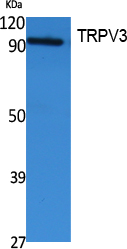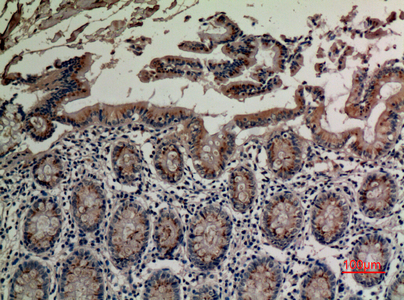TRPV3 Polyclonal Antibody
- Catalog No.:YT5095
- Applications:WB;IHC;IF;ELISA
- Reactivity:Human;Mouse
- Target:
- TRPV3
- Fields:
- >>Inflammatory mediator regulation of TRP channels
- Gene Name:
- TRPV3
- Protein Name:
- Transient receptor potential cation channel subfamily V member 3
- Human Gene Id:
- 162514
- Human Swiss Prot No:
- Q8NET8
- Mouse Gene Id:
- 246788
- Mouse Swiss Prot No:
- Q8K424
- Immunogen:
- Synthesized peptide derived from the Internal region of human TRPV3.
- Specificity:
- TRPV3 Polyclonal Antibody detects endogenous levels of TRPV3 protein.
- Formulation:
- Liquid in PBS containing 50% glycerol, 0.5% BSA and 0.02% sodium azide.
- Source:
- Polyclonal, Rabbit,IgG
- Dilution:
- WB 1:500 - 1:2000. IHC: 1:100-300 ELISA: 1:20000.. IF 1:50-200
- Purification:
- The antibody was affinity-purified from rabbit antiserum by affinity-chromatography using epitope-specific immunogen.
- Concentration:
- 1 mg/ml
- Storage Stability:
- -15°C to -25°C/1 year(Do not lower than -25°C)
- Other Name:
- TRPV3;Transient receptor potential cation channel subfamily V member 3;TrpV3;Vanilloid receptor-like 3;VRL-3
- Observed Band(KD):
- 90kD
- Background:
- transient receptor potential cation channel subfamily V member 3(TRPV3) Homo sapiens This gene product belongs to a family of nonselective cation channels that function in a variety of processes, including temperature sensation and vasoregulation. The thermosensitive members of this family are expressed in subsets of sensory neurons that terminate in the skin, and are activated at distinct physiological temperatures. This channel is activated at temperatures between 22 and 40 degrees C. This gene lies in close proximity to another family member gene on chromosome 17, and the two encoded proteins are thought to associate with each other to form heteromeric channels. Multiple transcript variants encoding different isoforms have been found for this gene. [provided by RefSeq, Apr 2012],
- Function:
- function:Putative receptor-activated non-selective calcium permeant cation channel. It is activated by innocuous (warm) temperatures and shows an increased response at noxious temperatures greater than 39 degrees Celsius. Activation exhibits an outward rectification. May associate with TRPV1 and may modulate its activity.,similarity:Belongs to the transient receptor family. TrpV subfamily.,similarity:Contains 3 ANK repeats.,subunit:May form a heteromeric channel with TRPV1. Interacts with TRPV1.,tissue specificity:Abundantly expressed in CNS. Widely expressed at low levels. Detected in dorsal root ganglion (at protein level).,
- Subcellular Location:
- Membrane; Multi-pass membrane protein.
- Expression:
- Abundantly expressed in CNS. Widely expressed at low levels. Detected in dorsal root ganglion (at protein level). Expressed in the keratinocyte layers of the outer root sheath and, to lesser extent, to the matrix of the hair follicles (at protein level).
- June 19-2018
- WESTERN IMMUNOBLOTTING PROTOCOL
- June 19-2018
- IMMUNOHISTOCHEMISTRY-PARAFFIN PROTOCOL
- June 19-2018
- IMMUNOFLUORESCENCE PROTOCOL
- September 08-2020
- FLOW-CYTOMEYRT-PROTOCOL
- May 20-2022
- Cell-Based ELISA│解您多样本WB检测之困扰
- July 13-2018
- CELL-BASED-ELISA-PROTOCOL-FOR-ACETYL-PROTEIN
- July 13-2018
- CELL-BASED-ELISA-PROTOCOL-FOR-PHOSPHO-PROTEIN
- July 13-2018
- Antibody-FAQs
- Products Images

- Western Blot analysis of extracts from CACO-2 cells, using TRPV3 Polyclonal Antibody. Secondary antibody(catalog#:RS0002) was diluted at 1:20000

- Immunohistochemical analysis of paraffin-embedded human-colon, antibody was diluted at 1:100



